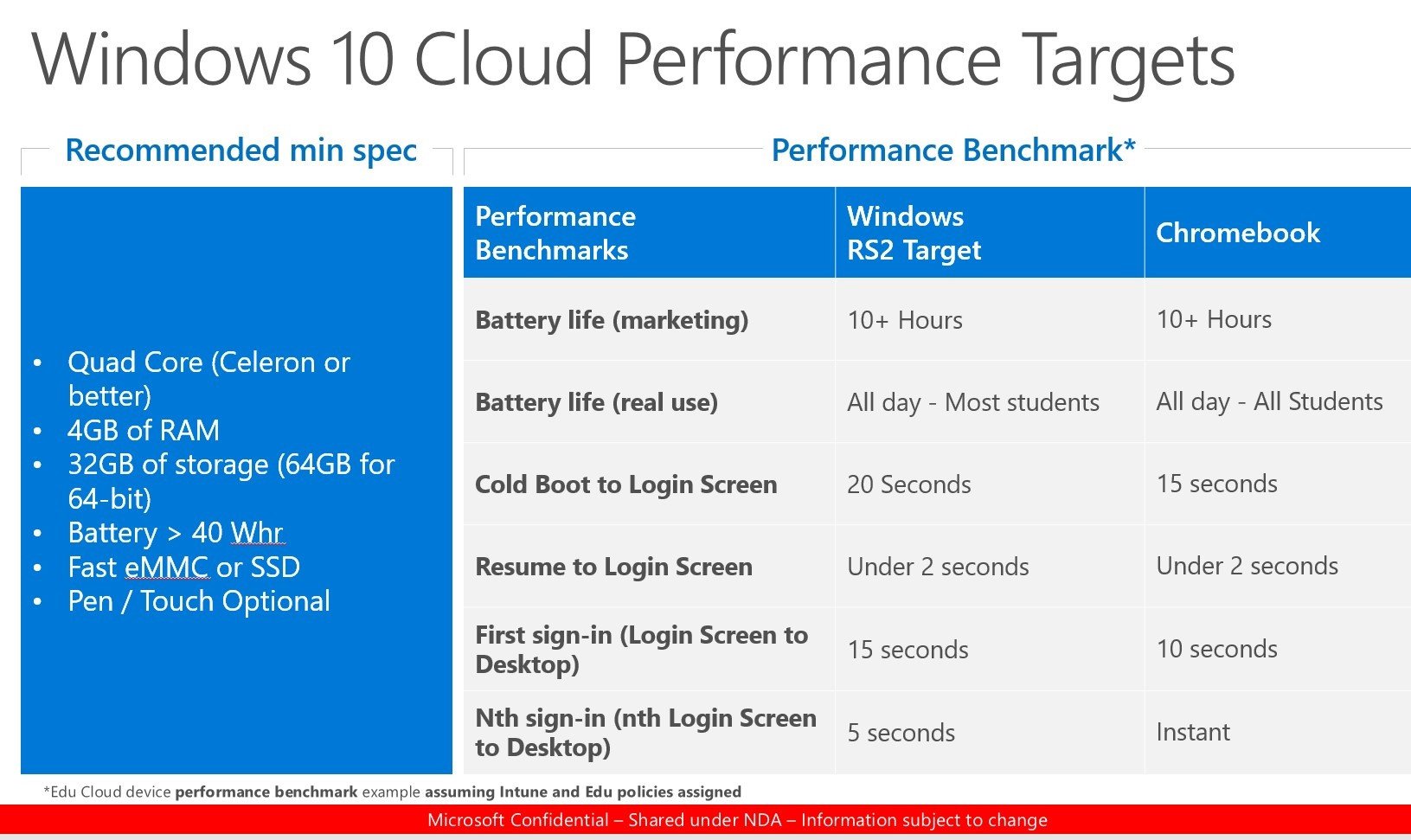Microsoft's new push into education is the right move — at the right time
A new low-cost Surface device and Windows 10 Cloud OS combo could do some serious damage to Google's Chromebook ambitions in U.S. schools.

On May 2, all eyes will be on Microsoft at its New York City event. Microsoft CEO Satya Nadella is expected to take the stage and unveil a new push into the education market, likely focused on the U.S. initially.
Google has been making big inroads into the K-12 education sector with its low-cost and easy-to-manage Chromebooks. According to IDC's latest numbers, Chromebooks represented 49 percent of that market last year, up from 40 percent in 2015 and just 9 percent in 2013.
Another research firm, Futuresource, puts the number even higher at 58 percent, up from 50 percent in 2015.

Apple, which has taken the brunt of the damage from the Chromebook wave in education in the U.S, meanwhile lost significant momentum in recent years. Apple's iOS, featured on the waning iPad series, went from a peak of 26 percent of the market in 2014 to just 14 percent last year, according to Futuresource.
Microsoft's Windows, by comparison, did better, dropping from 25 percent to 22 percent in that same time period.
For non-U.S. markets, the tale is very different. There, 65 percent of the education market is Windows, with Chrome OS at just six percent and Android at 17 percent. Apple held steady at just nine percent of the global education K-12 markets.
The timing is right for Windows 10 Cloud
Google is on to something with its Chromebook line, at least in the U.S. Combined with hardware support from major manufacturers, a mature app ecosystem, and ease of IT management, Chromebooks are the preferred choice for school IT departments.
Get the Windows Central Newsletter
All the latest news, reviews, and guides for Windows and Xbox diehards.
In speaking with some local school IT administrators – both public and private – here in Marlborough, Mass., it is the ability to lock down and secure Chromebooks, followed by cost, that is driving Chromebook adoption.
7 things you need to know about Windows 10 Cloud
Microsoft is poised, however, to get back into education. Windows RT was a disaster for the company on many levels, including its confusing name, poor marketing, software limitations, and pricing.
The Windows 10 Cloud OS, which may go by the name "Windows 10 S" when unveiled on May 2, is a different scenario. This time, Microsoft has a story to tell and a strategy to market this version of Windows to the right audience.
Key differences between Windows RT and Windows 10 Cloud OSes include:
- A more mature Store for Windows Universal Windows Platform (UWP) apps.
- The ability for the OS to be upgraded to a Home or Pro license.
- Capacity to run Win32 apps via "Project Centennial" bridge apps via the Store.
- A hardware team that's more in tune with commercial and consumer needs and desires.
Combined with advancements in hardware and improvements to the OS, Microsoft has clear goals it wants to achieve with Windows 10 Cloud.

In an internal document obtained by Windows Central (above), we can see exactly how Microsoft views Windows 10 Cloud as competing against Chromebooks in performance benchmarks.
Additionally, recommended minimum specifications for a Windows 10 "CloudBook" are listed for hardware manufacturers:
- Quad-core (Celeron or better) processor.
- 4GB of RAM.
- 32GB of storage (64GB for 64-bit).
- A battery larger than 40 WHr.
- Fast eMMC or solid state drive (SSD) for storage technology.
- Pen and touch (optional).
Microsoft is focusing heavily on all-day battery life, as evidenced by its new "Power Throttling" initiative that's being tested in recent Windows Insider Program previews for the "Redstone 3" release expected this fall.
Windows 10 on ARM will go further
Windows 10 on ARM is another big step for Microsoft that is expected to come to fruition this fall, as well. With the ability to run what was an x86/64 OS on mobile ARM processors, the company can further drive down hardware costs, improve battery efficiency, and make thinner and lighter devices.
Intel is making significant strides in reducing battery consumption, and Microsoft's Power Throttling goes further. According to the company, its Power Throttling support will be extended to other processor types (currently it is limited to 6th and 7th Generation Intel processors), which likely includes ARM.
The Achilles heel of Windows laptops has always been two-fold: poor battery life, and risk management due to viruses and installing .exe software. Both of those problems are now being ameliorated through Windows 10 Cloud.
Windows 10 on ARM devices are expected at the end of 2017 in the fourth quarter.
Today's Surface Book is too expensive
The current problem for Microsoft and its Surface line is the price.
At Microsoft's Surface Studio event in October 2016, Microsoft's Corporate Vice President of Devices Panos Panay used a photo of his son to demonstrate how children naturally adopt digital inking on a PC. In the picture, presented as a backdrop, the child is using a Surface Book. That device starts at $1,600 and increases to more than $3,000 for the high-end version.

While in a perfect world all kids would be able to afford a Microsoft Surface Book, the chances of that happening are minuscule. Clearly, Microsoft needs a lower-cost, entry-level device that provides a similar experience with an emphasis on a touchscreen and digital pen.
A new "Surface Laptop" running Windows 10 Cloud is the ideal solution, if it meets the minimum hardware specifications mentioned earlier. It also could also replace the now deprecated non-pro Surface 3.
Microsoft is expected to announce such a device on May 2, though some of our sources say the new hardware may not come until Microsoft's Build conference the following week.
A traditional laptop without a detachable keyboard would keep production costs down (fewer product SKUs), and it would work for schools, where losing a keyboard (or breaking it) could cause headaches for IT staff. As a solution to making the laptop more Surface-like, the keyboard could rotate around like Lenovo's Yoga series or HP's x360 line.
I also suspect a Surface Pen will be a part of any Surface Laptop, because the recent Creators Update focuses on inking.

Likewise, the seemingly odd addition of EPUB support for the Edge web browser and corresponding digital book section in the Windows Store makes more sense once you bring education into the equation.
However, one issue Microsoft could face in schools is app selection. While UWP is evolving and improving the selection of quality apps specifically related to education, it cannot possibly match the Google Play Store. That could change over time, and perhaps Microsoft has some strategies in place to help lure companies to create apps specifically for this genre.
Windows 10 Cloud and Surface for schools makes sense
Recently, a nephew of mine who is nine years old saw my Lenovo ThinkPad X1 Carbon. He said, "That looks like my Chromebook." I jokingly corrected him by stating "No, your Chromebook looks like my PC laptop."
The point should be obvious: The education market is critical to Microsoft's future based purely on familiarity. The debate between macOS and Windows preference, for instance, almost always comes down to what you were exposed to first. Rarely in today's world do adults try both OSes, evaluate them equally and come to rational decisions.

If Google is already at 50 percent adoption in the U.S. education market, that is a generation that's now in the Google and Android ecosystem. Microsoft needs a plan to take that on and, for once, I feel like it may have some significant advantages with Windows 10 Cloud and a new Surface. The recent announcement that it will align the servicing models for Windows 10, Office 365 ProPlus, and System Center Configuration Manager also likely plays a part in this plan.
Windows 10 Redstone 3: Everything we know so far
Microsoft's hardware partners are likely to pick up the slack and deliver even lower cost hardware to run Windows 10 Cloud in the coming months in preparation for fall 2017. All of that combined with Apple's declining popularity in schools is a perfect opportunity for Redmond.
As such, Microsoft's May 2 event could be the start of a significant push for the company — one that will have a lasting effect on a new generation.

Daniel Rubino is the Editor-in-chief of Windows Central. He is also the head reviewer, podcast co-host, and analyst. He has been covering Microsoft since 2007 when this site was called WMExperts (and later Windows Phone Central). His interests include Windows, laptops, next-gen computing, and wearable tech. He has reviewed laptops for over 10 years and is particularly fond of 2-in-1 convertibles, Arm64 processors, new form factors, and thin-and-light PCs. Before all this tech stuff, he worked on a Ph.D. in linguistics, performed polysomnographs in NYC, and was a motion-picture operator for 17 years.
